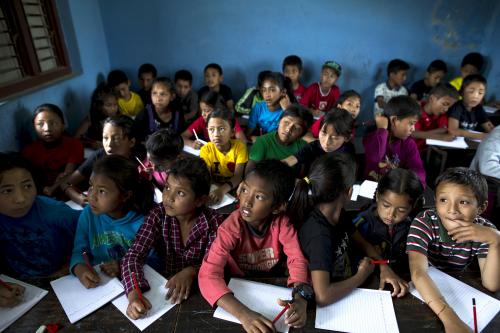As the school year lets out for millions of children across the globe, we are reminded of the work we need to do so that many more of the 58 million out-of-school children have the opportunity to start back to school in the fall.
Following yesterday’s Global Partnership for Education replenishment, the global community must now follow the roadmap that exists until the end of 2015 where pledges turn into the reality of universal education.
As Jeff Sachs pointed out, “there is something absurd, and deeply troubling, about tens of millions of impoverished children being out of school, often in conflict zones, because of a lack of financing so modest it should make us blush.” We face a crisis of declining aid for education and a rising out-of-school population. A failure to correct this trajectory and live up to the promise of universal education will not only delegitimize the post-2015 agenda for education, but leave behind the millions of children who deserve equal opportunity.
The UN Special Envoy for Global Education has said that the road to universal education requires unwavering determination and focus if we are to reach our goal. It is time for development banks, bilateral donors, multilateral donors and domestic governments to work together to strengthen systems and tackle the specific challenge of out-of-school children. If we combine financing and deliver capacity with political will and coordination across all sectors, there is still time to prove that having every single child in school and learning is not only feasible, but achievable.
It is time for top-down political efforts to coalesce with grassroots mobilization to deliver results in the countries with high burdens of out-of-school children. Just like Jubilee Drop the Debt and Make Poverty History, everyone has a role to play: faith groups, businesses, civil society, teachers, NGOs, and youth.
The new social movement of our time is part of the 500 Day #EducationCountdown campaign, where A World at School has mapped out, alongside hundreds of civil society partners, one-hundred day cycles and progress points, targeting countries in need with an eye for equity for the most marginalized. Before the school year starts in September, there are at least four tangible results we can deliver for children on our way to meeting the 2015 goal:
- Finance the plan for education for Syrian refugees: It is possible for 413,000 Syrian refugees and vulnerable children, now residing in Lebanon, to go to school in September. There is a plan and the Lebanese government has been generous in accommodating the refugee population with existing infrastructure. For a little over a $1 per child per day, we could fully finance the $177.2 million plan to ensure they all have a place at school in September and do not become a lost generation.
- Create Safe Schools in Nigeria: In Northern Nigeria, education is under attack. Following the kidnapping of the Chibok girls, the government has shown tremendous leadership with the private sector and global community to establish a “Safe Schools Initiative.” Agreed with the central government and the governors of Borno, Yobe and Adamawa, a fund to provide community and school-based interventions has been established. If ten donors contributed $4 million each, combined with the business sector contribution, we would have $50 million to co-finance government investments.
- Protect education: Over half of the out-of-school population lives in conflict affected areas. The draft Lucens Guidelines, a set of principles developed in a consultation process coordinated by the Global Coalition to Protect Education from Attack to protect schools and universities from military use during armed conflict, would give schools the same protection status as hospitals in conflict areas. We must encourage all countries to signal that they will support and ratify the guidelines – so that education does not come under attack.
- Finance the First Child Marriage-Free Zone in Pakistan: Every year, 14 million girls are married off and forced out of education. But we now have the opportunity with Idara-e-Taleem-o-Aagahi to finance the first-ever child marriage-free zone in Pakistan so that young girls are supported in protecting the right to education in their communities.
These four milestones could make the difference between opportunity and oppression for millions of children. And they could all be achieved before September. As we count down until the 2015 deadline, our final push and journey should be marked by successes. Failure is not an option. The stakes are too high.
The Brookings Institution is committed to quality, independence, and impact.
We are supported by a diverse array of funders. In line with our values and policies, each Brookings publication represents the sole views of its author(s).











Commentary
Delivering Results for Children: Achievable Milestones Toward 2015
June 27, 2014